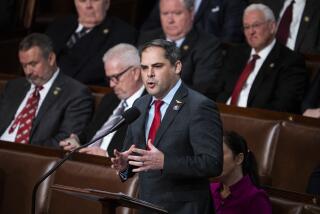Campaigning to Give All Kids a Fair Chance
From the same people who brought you “Friends Don’t Let Friends Drive Drunk,” “Only You Can Prevent Forest Fires” and “A Mind Is a Terrible Thing to Waste” comes their most ambitious advertising campaign yet. It aims to create a sea change in the way America views its children, especially those in the inner cities. Its hoped-for result: that virtually every American child will grow up with “a decent adult advocate,” says Alex Kroll.
Kroll, 58, is chairman of the New York-based Ad Council, a nonprofit group that, with financial backing from major U.S. corporations, creates public-service advertising campaigns. Its TV spots are sent to networks and local stations, which run them in available time slots at no charge.
The new campaign, whose spots feature urban parents battling against drug dealers and others who would prey upon their children, culminates with the slogan “Whose Side Are You On?” It began last July and is scheduled to run 10 years, compared to the more traditional three to six months for most commercial campaigns.
The ads have run more than 90 times on Los Angeles stations KCBS-TV Channel 2, KCOP-TV Channel 13, KABC-TV Channel 7, KCAL-TV Channel 9 and KTLA-TV Channel 5, according to the Ad Council.
Yooli Pak, community relations spokesperson for KCOP, said that her station is running the ads on a weekly basis because “we think there is a need to have a positive image on TV for kids who are high risk. The ads also rally people not familiar with the inner city to, in a tangible way, help better the lives of all our kids.”
The campaign was born two years ago at a regular Ad Council meeting when representatives of 70 major corporations agreed in a record 35 minutes to marshal their forces for this effort on behalf of poor urban children, said Kroll, a former chairman of the Young & Rubicam ad agency.
As with commercial campaigns, they then convened a series of focus groups throughout the country, each consisting of 10 to 20 people who met an average of three hours. Group leaders discovered the public to be “absolutely frozen” by the dilemmas of these youngsters “because they see those problems as so pervasive and hopeless,” Kroll said.
At the same time, focus group leaders discovered that the public put the blame for the situation on “irresponsible parents. Inner-city parents were seen as the real villains, the abusers of drugs and alcohol. The public thought they shouldn’t even have kids,” he said.
Finally, group leaders determined that most of the public had formed such opinions through the media, not through personal experience. This gave Kroll his opening.
“We saw we had a chance to break down stereotypes, to give a truer picture of what parents are going through,” he said.
*
Believing that “Americans are willing to help people who are trying to help themselves,” Kroll said, the Ad Council shot its first five spots, ranging from 30 to 60 seconds, in black and white, documentary-style.
One of the two 60-second spots features the Los Angeles chapter of Mad Dads, a group of ex-gang members patrolling the streets to keep their neighborhoods safe from gangs and drug dealers. The ad closes with a Mad Dad walking into the room of his sleeping 4-year-old and kissing him on the forehead.
The other spot features a young mother who has just gotten a drug dealer for a next-door neighbor. Worrying whether she will be able to keep her two children safe from him, she looks at him through her screen door. He stares back at her. “Whose side are you on?” the narrator asks.
As with traditional campaigns, the Ad Council will poll viewers to measure changes in public attitudes so it can fine-tune future spots.
Reginald Brack, chairman of Time Inc. and an Ad Council board member, said that advertising’s ability to help change the public’s behavior has already been proven. Why stop, then, at merely promoting a different type of car or toothpaste? “Why can’t we also do something about teenage pregnancy and drugs?” he asked.
As a byproduct of the campaign, Brack expects the news media to be inspired to produce more stories on the hardships faced by the nation’s children. And he predicted, “Five years from now, as a result of this keystone campaign, the apathy about the problems of children will be erased.”
The “Whose Side Are You On?” campaign “is not remotely comparable to any previous campaign,” Kroll said. “What’s at stake is the future of a lot of innocent kids. We’re talking about the future of America.”
More to Read
Sign up for Essential California
The most important California stories and recommendations in your inbox every morning.
You may occasionally receive promotional content from the Los Angeles Times.










